Abstract
Under normal circumstances, movement is relatively suppressed during sleep. Motor system activity reflects this paucity of movement as it decreases from drowsiness to slow wave sleep (SWS) and then further in rapid eye movement (REM) sleep. Some movement during sleep in fact is adaptive with small shifts in body weight preventing pressure-related injuries such as nerve palsy and skin ulceration. Other movements occurring during sleep serve no obvious purpose and may even fragment sleep, especially when recurrent. This latter constellation of movements constitutes the sleep-related movement disorders. This chapter will focus on the sleep-related movement disorders which are largely characterized by repetitive, non-epileptic, purposeless movement which occurs during sleep. Many of the sleep-related movement disorders are clinically benign or on the severe end of the normal spectrum and as such our discussion will begin with an introduction to normal movement during sleep. The chapter continues with a discussion of benign sleep-related movement then the clinically recognized sleep-related movement disorders. Special attention will be given to restless legs syndrome (RLS) and periodic limb movement disorder (PLMD) as these entities are both common and a major source of morbidity.






















